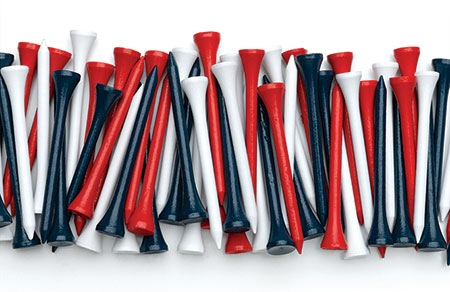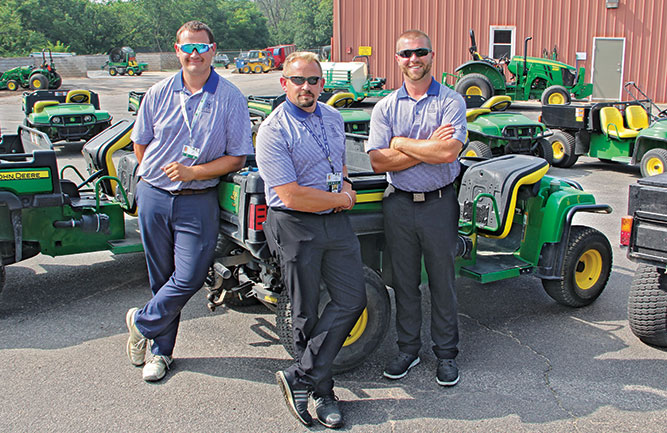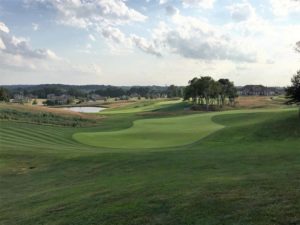Web Exclusive: More from the 2019 State of the Industry report part 1

Photo: AdShooter/Stock/Getty Images Plus/Getty Images
2019 was a year of many successes, multiple challenges and happily, a few near misses.
An inaccurately forecast hurricane saved a lot of superintendents some trouble (but not the unnecessary prep work), while floods and drought were common themes in this year’s report. The labor challenge? We had to laugh when Daniel Francis, president of the Cincinnati GCSA, said, “I’m not going to talk about labor. Everyone knows labor is a problem.”
For our 2019 State of the Industry report, sponsored by Nufarm, we once again embarked on a journey to learn what the golf season was like across the country. We talked to GCSAA chapter presidents and representatives to learn about regional weather, disease pressures, challenges and successes.
Below are additional reports to be added onto the 2019 State of the Industry report. To jump to a specific interview, click on their name below.
- Illinois: Alex J. Stuedemann, CGCS
- Kentucky: Anthony Williams, GCSAA Class A Member
- North Carolina: Brian J. Stiehler, CGCS, MG
- Nebraska: Greg Jones, CGCS
- South Dakota: James J. Walraven, CGCS
- Arkansas: Jeff Haskins

The crew at TPC Deere Run. Stuedemann is front and center. (Photo: Golfdom Staff)
Alex J. Stuedemann, CGCS
President, Northwest Illinois GCSA
Director of Golf Course Maintenance Operations, TPC Deere Run, East Moline, Ill.
Generally speaking, how was the golf season in your region?
The golf season in our region was probably the shortest on record — with a late start into April, followed by torrential rainfall well into early June, and then an abrupt end around Halloween. This challenged everything from superintendents’ tolerance of Mother Nature to keeping team morale up to simply realizing enough revenue to meet expenses.
How was the weather for your area this year?
As mentioned, the weather was terrible, as it led to an extremely short season. Rain, rain and more rain.
What was the disease pressure like in your area in 2019?
It definitely seemed like it was less than in 2018, despite the aforementioned wet weather. I think a lot of lessons were learned, and turf managers were very proactive about staying ahead of any sort of disease vectors, especially with regard to root dysfunction and summer decline.

Stuedemann spoke with Editor-in-Chief Seth Jones about hosting the 2019 John Deere Classic. Click here or click the photo to view the full interview. (Photo: Golfdom Staff)
What was the biggest challenge faced by your area this year?
By far, the overabundance of moisture, along with trying to meet guest expectations despite a limited ability to maintain playing surfaces — while also trying to keep turf healthy and strong.
Were there any notable success stories from your area/chapter this year?
Regardless of the weather, the camaraderie of the industry shone through, whether it was loaning equipment between courses when the conditions allowed for work to get done, or more importantly, seeing our peers band together through donations to the Wee One Foundation to support two of our own who were afflicted with recurrences of their cancer. It was a great reminder that what we do really isn’t about the turf, it’s about the people.
What are your expectations for 2020?
Although it’s always hard to prognosticate the future, the lessons we have cumulatively learned — from the weather, guest demands and financial challenges over the last decade — have made us so resilient that I’m positive we’ll be ready and our properties will be the best they can be, no matter what 2020 wants to throw at us.
Anthony Williams, GCSAA Class A Member
President, Bluegrass GCSA
Superintendent, Daneville Country Club, Danville, Ky.
Generally speaking, how was the golf season in your region?
Overall, it was good across our chapter. Rounds seemed to be at normal levels at most of Kentucky’s courses. And one of our courses hosted a PGA Tour event (the Barbasol Championship at Nicholasville’s Keene Trace Golf Club) on the hottest weekend of the year.
How was the weather for your area this year?
The weather was unpredictable in Kentucky. The past couple years — before 2019 — were some of the wettest years on record, but in 2019 we saw our rain come in waves. We got a lot of rainfall at one time, and then it seemed to just stop until it finally turned cool to close out the season.
What was the disease pressure like in your area in 2019?
Just like the weather, disease pressure in our area came in waves. At my course, I saw more dollar spot than normal on playing surfaces. Once the drought set in, disease pressure subsided. I spoke to one superintendent who didn’t spray a fungicide on his greens for almost five weeks.
What was the biggest challenge faced by your area this year?
The biggest challenge, as always, was labor and weather. Mother Nature is always one of our biggest challenges. We can’t control the weather, so we always have to be ready to adjust our plans to whatever the weather is giving us. Like most areas in golf, finding dependable labor seems to be one of the biggest challenges. To find labor, courses are trying to become more creative. Our area’s turf programs have been declining, so finding young people who are interested in turf is difficult. At my course, we partnered with a drug rehab program, which was the best crew we have ever had.
Were there any notable success stories from your area/chapter this year?
The successes in our area had to be the superintendents. We all faced different kinds of adversity; even so, everyone found a way to always put the best product out there for the golfers. Last year was not easy, and everyone just kept working hard for their golf courses.
What are your expectations for 2020?
In 2020, we will probably see more of the same as the past few years. We seem to be dealing with extremes now. Spring/fall seasons seem shorter, there are more severe growing seasons and it is more difficult to find dependable labor. However, we all continue to work together to find solutions to grow the game of golf. 2020 will — hopefully — be another successful year in the Bluegrass.
Brian J. Stiehler, CGCS, MG
President, Carolinas GCSA
Superintendent Highlands Country Club, Highlands, N.C.
Generally speaking, how was the golf season in your region?
Overall, the Carolinas had a great year. It was a good year for golf in the two states, as four USGA championships were held in the region: the U.S. Women’s Open, the U.S. Senior Women’s Open, the U.S. Amateur and the U.S. Senior Amateur. Those four events, as well as the Wachovia Championship at Quail Hollow Club, allowed golf in the Carolinas to receive more attention. Congratulations to those greenskeeper teams for their success during those events.
How was the weather for your area this year?
North and South Carolina are different than many areas because of varying climates from one end of the Carolinas to the other. There is a hot, humid coastal region, Sandhills, Piedmont, upstate South Carolina and then western North Carolina, which all have different climates that support various turfgrasses from bermuda to bentgrass/Poa annua. For many, hot and dry summed up our year. October set records for temperatures, which reached 100 degrees during the month. In Charleston, Paul Corder and his staff dealt with 100-degree F days during the U.S. Women’s Open on Memorial Day weekend. In other areas of the chapter, superintendents dealt with too much rain at times, including over 110 inches in parts of western North Carolina. Upstate South Carolina also dealt with excessive rain at various times during the year.
What was the disease pressure like in your area in 2019?
Based on the number of samples submitted to Lee Butler and Dr. Jim Kerns at NC State University, Pythium root rot, anthracnose and summer patch were the top three submissions, in that order. Of course, spring dead spot always is an annual challenge for many superintendents who are growing bermudagrass, but research and new product development is slowly improving the control superintendents are able to achieve. Meanwhile, the top three diseases on bermudagrass putting greens in the Carolinas during 2019 were take-all root rot, mini ring and Pythium blight, respectively. It certainly wasn’t the worst year we’ve seen in terms of disease pressure, compared to years past.
What was the biggest challenge faced by your area this year?
Like most areas in the United States, labor continues to be the biggest area of concern and frustration for most superintendents. Last year, many facilities didn’t receive their H-2B seasonal staffing. In western North Carolina, this was particularly devastating for some, given the rural nature of the area and the lack of local persons available to fill those positions. This led to many going to Plan B, whatever that was — even if it meant getting a crew with no past golf course experience and starting from the ground up. Due to a currently low unemployment rate along with competition from other industries, this is sure to be a challenge that won’t go away anytime soon.
Were there any notable success stories from your area/chapter this year?
There are always success stories coming from the Carolinas. In 2019, the Country Club of Charleston hosted the U.S. Women’s Open. Also, Quail Hollow Club once again hosted the Wachovia Championship in May. In addition to those two events, the U.S. Senior Amateur was held at Old Chatham Golf Club, the U.S. Amateur was hosted at Pinehurst and the U.S. Senior Women’s Open was held at Pine Needles Lodge and Golf Club. Most importantly, there are everyday success stories of superintendents who do so much with few resources. Their creativity, work ethic and attitude amaze me. At the 2019 Carolinas GCSA Conference and Show, Wayne and Steve Smith received the Distinguished Service Award from the association for everything they’ve done, along with the support they continue to offer the industry through their business, Smith Turf and Irrigation. In addition, one of our own, Paul Jett, successfully qualified and participated in the U.S. Senior Amateur at Old Chatham. Also, Pat O’Brien, a longtime USGA agronomist, called it a career and is now enjoying retirement and hoping the Pittsburgh Steelers have a better season (with fewer injuries) this year. Finally, our Carolinas GCSA team — consisting of our fearless leader, Tim Kreger, who is supported by Melissa Smith, Angie Davis and Kim Clark — is a constant success story. This is a dynamic team that serves our membership well and seems to be everywhere at once. No task is too small, and they are some of the reasons for the annual success of our conference and show. In addition, they balance the everyday details of running our association like the professionals they are.
What are your expectations for 2020?
That’s a good question. Personally, I’m expecting a great season with ideal temperatures, low humidity and rain events timed with precision. My work environment will lack any politics, and new staffing candidates will be lined up outside my office door. All candidates will be willing to work outside (on holidays) in varying climatic conditions. And members will begin to fix all ball marks and replace all divots with care. Well … we all know that’s not happening. While I can’t predict the future, let me conclude by saying — as superintendents — we’ve taught ourselves to make do with what we’re given. We’re great leaders and problem solvers, and whatever Mother Nature or anyone else throws at us, we’ll deal with it. Every year is a series of wins and losses, but it’s those losses that keep me motivated to achieve some level of perfection. We keep learning and experimenting, and that adds value to every one of us.
Greg Jones, CGCS
President, Nebraska GCSA
Superintendent Champions Run Golf Course, Omaha, Neb.
Generally speaking, how was the golf season in your region?
The golf season in our region was not typical, but since we’re in Nebraska, there is no such thing as typical. The rounds were up and so was the moisture for most of the season. All in all, things were good last year.
How was the weather for your area this year?
I’ve now been employed at Champions Run Golf Course for nearly 10 seasons, and there have not been two years alike. Last year, the floods around us, along with the excessive moisture to start the year, gave us some trouble. Minus the floods, I would take the weather from last year again, though.
What was the disease pressure like in your area in 2019?
Disease pressure in our region was better last year than it had been the past couple years before that. Grey leaf spot affected quite a few of us in 2018, and I feel like it was better in 2019. Putting a newer variety in the mix has helped.
What was the biggest challenge faced by your area this year?
We have a strange challenge here in Nebraska. Sand is plentiful for topdressing and other golf course needs, but everyone was flooded out, so getting good quality sand was very difficult.
Were there any notable success stories from your area/chapter this year?
There were a lot of success stories, mostly guys overcoming the floods of the spring. One I would like to mention is Josh Hegy, superintendent at The Pines Country Club in Valley, Neb. I called Josh and asked him how he was holding up, knowing how flooded his course was, and he asked me if I needed anything. That isn’t something you see every day. There were multiple people who told me Josh helped them way before he helped himself.
What are your expectations for 2020?
As a maintenance staff, our expectations are as high as ever. I have a full-time staff with everyone returning and a lot of seasonal guys coming back. We are very excited for a great year.
James J. Walraven, CGCS
President, South Dakota GCSA
Superintendent Meadowbrook Golf Course, Rapid City, S.D.
Generally speaking, how was the golf season in your region?
In South Dakota, we are divided by the Missouri River. We South Dakotans recognize our state in two divisions: East and West River. In many ways, we are totally different — topography, weather and population to name a few. I work in the western side of the state, so I can really only answer from my end. During our golf season, play was down, and the weather had a lot to do with it.
How was the weather for your area this year?
The season was short due to late spring snowstorms that lasted until May, so golfers weren’t able to play much last spring. When compared to 2018, we were down 15 percent in rounds in 2019, as the weather wasn’t much better a year before that. In comparison to 2016, we were down 34 percent in rounds. Snowfall last year was 36 inches — year-to-date as of December 2019 — our normal is 10.7 inches. And our year-to-date precipitation was 27.7 inches; our annual in this semi-arid region is 16 inches.
What was the disease pressure like in your area in 2019?
Disease pressure was low last year. We didn’t hear of anything out of the ordinary in my area.
What was the biggest challenge faced by your area this year?
Flooding was quite common throughout South Dakota because of the continuous heavy rains that occurred across the Northern Plains.
Were there any notable success stories from your area/chapter this year?
Our chapter was one of the first to finish the BMP for the GCSAA, and we had two superintendents achieve CGCS status. In fact, the South Dakota GCSA probably has more certified superintendents per capita — considering the number of golf courses and membership in the state — than the rest of the United States.
What are your expectations for 2020?
We would like to turn back the clock to three to five years ago — when the golf climate was pretty good for everyone across our great state.
Jeff Haskins
President, GCSA of Arkansas
Superintendent Paragould Country Club, Paragould, Ark.
Generally speaking, how was the golf season in your region?
Generally, the season was regarded as good overall. The only mitigating issue was the numerous rain days we had. Last I heard, total golf rounds were slightly up in the state of Arkansas in 2019. The feeling throughout the industry is that we have some growth potential available in rounds and revenue, but it doesn’t take a lot to derail slight increases.
How was the weather for your area this year?
It was rainy for the better part of the regular golf season. In fact, some areas received 200 percent more rainfall than normal. At my facility, the remnants of hurricane Barry in late July caused some turf damage that lingered for the rest of the season, so the feeling is pretty pessimistic at our facility about last year’s weather. For much of the state, the wet weather was not so detrimental to turf, but it did put a damper on actual rounds played for the year.
What was the disease pressure like in your area in 2019?
Disease pressure did not seem to be a major problem. The availability of information, support and effective treatments for disease has been a major benefit to our industry, especially over the last five to eight years. We just don’t seem to see the regionwide outbreaks of disease that no one can figure out anymore.
What was the biggest challenge faced by your area this year?
The biggest challenge that Arkansas superintendents faced in 2019 was the maintenance of wet courses with limited staff under sometimes heavy golf pressure. Mother Nature notwithstanding, the biggest challenge facing our area, and our industry in general, would still have to be labor. Golf facilities, from the top to the bottom of the spectrum, are focused on trying to handle the labor issue in a variety of ways.
Were there any notable success stories from your area/chapter this year?
Nothing sticks out in my mind as a real surprise when it comes to success stories. There are a ton of successes happening every day in our industry. The lack of funding for earth-shattering transformational-type success stories has spawned a real movement toward small-scale, incremental improvements in environmental stewardship, conservation and overall efficiency of operation. The “leaning” of our industry and a move toward sustainability is a success that can’t be overstated.
What are your expectations for 2020?
I believe 2020 will be a very good year for the golf business. The economy, in general, will be the big question we’ll all be seeking the answer to. Things are going well, but election years have shown to be tricky in the past, and it seems like something always comes along that prevents a huge jump in the fruits of our labor. I like our chances, though.









